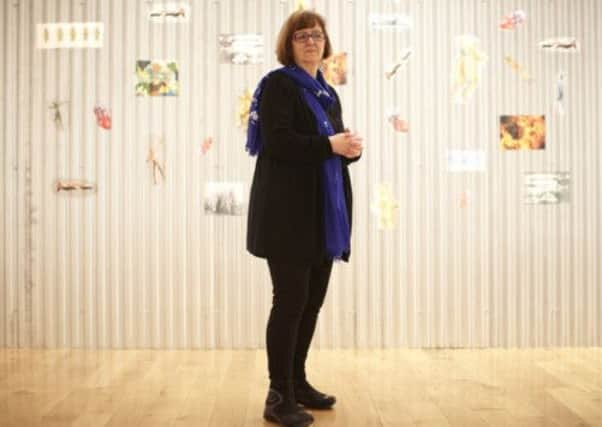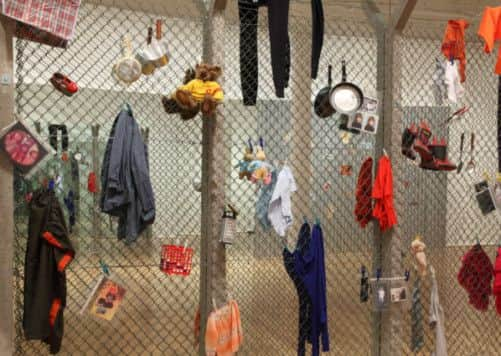Veteran artist with eyes on the Northern Art Prize


ON the face of it, Margaret Harrison doesn’t strike you as a controversial artist.
Polite and mild-mannered, it’s hard to believe this softly-spoken grandmother once had an exhibition shut down by police on the grounds of indecency. But the Wakefield-born artist isn’t easily pigeon-holed having forged her creative spirit in the fires of the feminist movement and the avant-garde art scene that emerged during the 1960s.
Advertisement
Hide AdAdvertisement
Hide AdLast month, Harrison was unveiled as one of the artists shortlisted for this year’s Northern Art Prize. At the age of 72 she is the oldest person to make the final cut since the competition, the biggest art prize in the North, was first launched in 2006.


“It’s a real honour to make the shortlist especially given the fact that I was born in Yorkshire,” she says. “The Northern Art Prize has gained a lot of recognition, not just in the region, but beyond. It might not be at the level of the Turner Prize but it’s extremely well respected.”
Harrison has been shortlisted for three pieces called Reflect, which consists of sculpture, painting and drawings. Among them is a reconstruction of a perimeter fence from the Greenham Common airbase which back in the 1980s was home to a women’s peace camp set up in protest against American cruise missiles being held there.
Harrison’s sculpture – Common Reflections – contains two concrete posts, wire, mirrors and corrugated zinc sheeting that is strewn with personal items such as children’s clothing, toys, photographs and pots and pans.
Advertisement
Hide AdAdvertisement
Hide AdShe visited Greenham Common on several occasions back in the 80s and talked to the women at the camp. “The fence itself was almost a piece of artwork like a canvas which people used to hang banners and paintings on and weave things into,” she says. “And I wanted to create a diary of images from the fence that were both personal and political.”
The Greenham Common protests were frequently in the news at the time and Harrison believes they had a greater impact than many people perhaps realise. “At the time, a lot of people said the protests were a waste of time and wouldn’t make a difference. But Mikhail Gorbachev later said he signed the peace document and was convinced that Europe didn’t want to have cruise missiles on its doorstep, because of the women at Greenham Common.”
Alongside her homage to the Greenham Common camp is a new painting, called The Last Gaze, based on John William Waterhouse’s The Lady of Shalott (1894), part of the Leeds Art Gallery collection. Waterhouse’s painting is about a cursed woman who can only view the world via mirrored images and Harrison takes the idea of reflection, pairing the image in both colour and black and white. On the adjacent wall rear-view car mirrors reflect Harrison’s painting, to confuse the audiences’ perceptions and play around with ideas of illusion and reality.
Both these works, along with those of fellow finalists Rosalind Nashashibi, Emily Speed and duo Joanne Tatham and Tom O’Sullivan, are featured in the Northern Art Prize exhibition at Leeds Art Gallery which runs until the middle of June.
Advertisement
Hide AdAdvertisement
Hide AdHarrison’s paintings and sculptures have been exhibited in places like New York and Berlin, a far cry from her humble childhood in West Yorkshire during the Second World War. She was born in Wakefield and lived there until she was eight, when her father got a teaching job in Cumbria and the family upped sticks and headed across the Pennines.
Her father was an amateur artist but her biggest influence was a schoolteacher, or two to be precise. “I had an English teacher who wanted me to go and study English, but I also had an art teacher who wanted me to do art, and she won.” She spent four years studying at Carlisle College of Art. “I absolutely loved it although I would have probably benefitted from going to a bigger art school, but at the time you only got your fees paid if went to a local college.”
From here she gained a place at the Royal Academy Schools, in London, although to begin with she didn’t enjoy life in the capital. “It was a huge shock. Very few kids went to London from the North and there was a little huddle of us that stuck together.”
As well as being a culture shock, it was also hard work. “In the first term you spent the whole time drawing and if you didn’t pass then you were out on your ear.”
Advertisement
Hide AdAdvertisement
Hide AdShe persevered and having survived that first term gravitated towards what she calls the “cool crowd” – those budding artists who wanted to “do something other than just paint women with bare arms.”
It was a good time to be young and living in the capital. “We had Carnaby Street just down the road and you were surrounded by all this amazing new fashion and music which influenced your work.” After graduating, she worked briefly as an art teacher in Manchester before returning to London in the late 1960s where she found a city thick with protest in the air. “I was living in Notting Hill Gate when the rent strikes were happening. The pill had just been developed, the women’s movement was emerging and the Vietnam protests were happening. People felt optimistic in the sixties and there was a sense that everything was getting better.”
In 1970, she helped found the London Women’s Liberation Art Group, but the following year her art show was closed down by police because it was deemed indecent. Among the works that caused offence was a painting of Playboy founder Hugh Hefner squeezed into a bunny girl costume and a kinky Captain America complete with fake breasts, suspenders and a stars ‘n’ stripes bodice.
“The Captain America piece was partly a reflection on the Vietnam War which was still going on, but with the Hugh Hefner drawing I reversed the image because I was trying to say that women had more than one career option.”
Advertisement
Hide AdAdvertisement
Hide AdDuring the 70s, her work blended pop art with feminism and a sense of ironic humour that stopped it being dismissed as militant. “I was interested in notions of sexuality and politics and what happened when you blurred the boundaries which was quite radical at that time,” she says. “A lot of us were breaking new ground, not just women but men, too. We came along with the belief that anything and everything was about art.”
So how does she look back on this period and being part of the feminist movement? “It was a life-changing experience and I believe it was as strong as the suffragette movement. A lot of my generation went to college and university but when they came out they found it difficult to get jobs. They hit a brick wall and there was a battle to get women in to the workplace, which we hadn’t expected.”
Given these experiences, it’s perhaps not surprising that politics and sexuality have been such major themes throughout her career, although these days her work is perhaps less strident than it once was.
In the last couple of decades, Harrison has spent time working as a lecturer and artist in both England and the United States and believes art remains just as important as it did 40 years ago. “It’s massively relevant, it’s one of the engines for redevelopment in the North which is why I’m worried about all the arts funding cuts. I think it’s very foolish especially when you consider how important something like the digital industry is.”
Advertisement
Hide AdAdvertisement
Hide AdBut even now, as a pensioner, she is still creating new work and being invited to take part in exhibitions. “You have to keep the flame going, you can’t rest on your laurels. I thought by this time in life I’d be sitting in a chair and nodding by the fire, but I’ve found I can’t do that.”
Which is why she’s so pleased to be among the contenders for this year’s Northern Art Prize. “I’m delighted because it’s the only prize that isn’t ageist and it’s in Yorkshire.”
• The winner of the Northern Art Prize will be announced on May 23. The exhibition at Leeds Art Gallery runs until June 16.